Global Glutamic Acid Market Forecast
- Global market for glutamic acid worth around US$10.6 Bn in 2022 to rise high up to US$16.1 Bn by 2030
- Glutamic acid market size forecast to observe a CAGR of 6.2% during 2023 - 2030
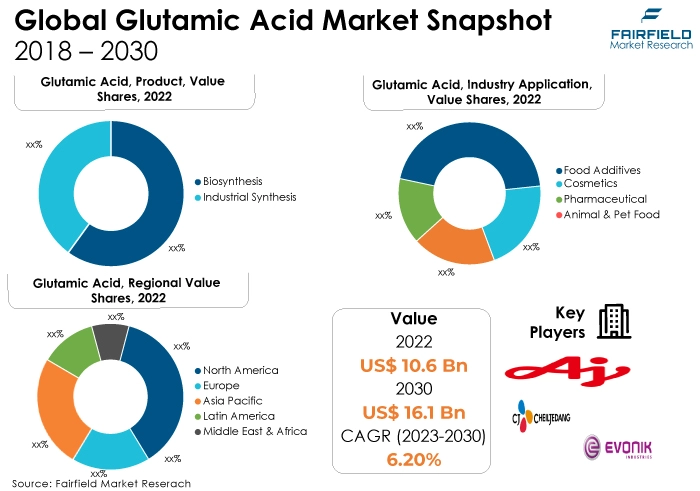
Quick Report Digest
- The key trend anticipated to fuel the growth of glutamic acid is the increasing demand from the food industry.
- The glutamic acid market is growing due to its widespread use as a flavour enhancer in the food industry. Increased consumer demand for processed and flavourful foods, coupled with changing dietary preferences, drives the market's expansion and adoption of various food products.
- The expanding food industry is driving the glutamic acid market as it relies on glutamic acid as a flavour enhancer. With consumers seeking tastier processed foods, the demand for glutamic acid, particularly monosodium glutamate (MSG), continues to rise, underpinning its growth in the food sector.
- Biosynthesis-derived glutamic acid is growing in the market due to its sustainable and cost-effective production process. It aligns with the industry's emphasis on eco-friendly practices, and its consistent quality meets stringent regulatory requirements. As consumer demand for natural ingredients rises, biosynthesis gains prominence.
- The Food Additives application dominates the glutamic acid market due to glutamic acid's role as a flavour enhancer. It provides the sought-after umami taste in various processed foods, making it a key ingredient in the food industry, aligning with consumer preferences for flavourful and convenient food options.
- North America dominates the glutamic acid market due to its strong emphasis on sustainability, strict environmental regulations, and well-established pharmaceutical and detergent industries. Consumer awareness and regulatory compliance drive the adoption of glutamic acid, cementing North America's market leadership.
- The Asia Pacific region is experiencing the highest value CAGR in the glutamic acid market due to rapid industrialisation, population growth, and increased consumption of processed foods. Growing food and pharmaceutical industries are driving the demand for glutamic acid in the region, contributing to its rapid growth.
- Regulatory compliance poses challenges in the glutamic acid market as it necessitates strict adherence to food safety and labelling regulations, including limits on additives like MSG. Diverse regional regulations require manufacturers to navigate varying compliance standards, impacting production processes, labelling, and market access.
A Look Back and a Look Forward - Comparative Analysis
The glutamic acid market is growing due to its widespread use in food and beverage industries as a flavour enhancer. It is a key component of MSG, a popular additive. Additionally, it finds applications in pharmaceuticals and cosmetics. Rising consumer demand for processed foods and increasing awareness of the umami taste have driven its growth, with emerging markets and research into its potential health benefits further fuelling demand.
The market witnessed staggered growth during the historical period 2018 - 2022. This is due to the substantial growth of the major end-use application sectors, such as food additives and animal industry. The food additives application is expanding in the glutamic acid market due to its role as a flavour enhancer and umami taste contributor. As consumer demand for processed and flavourful foods increases, glutamic acid's use in food products continues to grow, driving its application in the market.
The future of the glutamic acid market appears promising, driven by the continued demand for flavour enhancers in the food industry. As processed and convenience foods gain popularity, glutamic acid's role in enhancing taste is expected to grow. Additionally, research into potential health benefits and applications in pharmaceuticals and cosmetics may further diversify its market presence. Expanding global populations and changing consumer preferences are likely to fuel its continued growth.
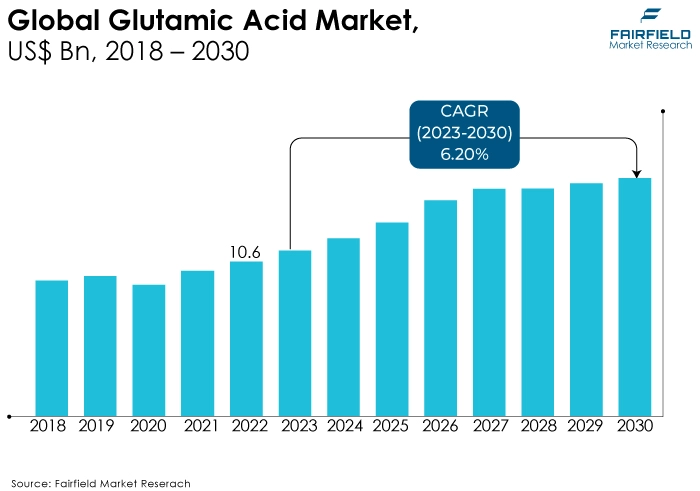
Key Growth Determinants
- Increased Demand from Food Industry
The glutamic acid market is experiencing growth due to increased demand from the food industry. Glutamic acid serves as a key flavour enhancer, providing the savoury ‘umami’ taste that consumers crave in processed and restaurant foods.
As the popularity of processed and convenience foods rises globally, so does the demand for glutamic acid as a food additive. This trend is further accelerated by the growing preference for flavourful and ready-to-eat dishes, positioning glutamic acid as a vital component in meeting consumer taste expectations in the food sector.
- Rising Adoption by Pharma Companies
Increased demand from the pharmaceutical industry is driving the glutamic acid market, as glutamic acid plays a crucial role in drug formulation and manufacturing. It serves as an essential component in the synthesis of various pharmaceuticals, including antibiotics and vaccines.
As the pharmaceutical sector continues to expand globally and innovate in drug development, the demand for glutamic acid as a key ingredient in these formulations grows, making it a valuable and in-demand resource within the industry.
- Increasing Preference Toward Natural Food Additives
The glutamic acid market is benefitting from the increasing preference for natural food additives. As consumers seek cleaner and healthier food options, natural ingredients like glutamic acid, found in sources like tomatoes and mushrooms, are gaining popularity as flavour enhancers.
The demand aligns with the clean label and eating trends, propelling the use of glutamic acid in natural food products, thereby driving its market growth in response to consumer preferences for more genuine and recognisable ingredients in their food.
Major Growth Barriers
- Potentially Harmful Effects
The glutamic acid market faces challenges related to concerns about potential harmful effects associated with its usage. Some individuals may experience adverse reactions, such as headaches or allergic reactions, from high levels of glutamic acid or salts like MSG (monosodium glutamate).
Such concerns have led to calls for more stringent labelling regulations and consumer education. As a result, addressing these perceptions and ensuring safety and transparency in glutamic acid use pose challenges and necessitate careful management within the market.
- Regulatory Compliance
Regulatory compliance presents challenges for the glutamic acid market as it operates within a complex web of international and regional regulations. Compliance with food safety and labelling regulations, including limits on additives like MSG, requires rigorous monitoring and adherence.
Additionally, variations in rules across countries add complexity to the market, requiring manufacturers to navigate a range of compliance standards. Meeting these regulations while ensuring product quality and consumer safety is a continuous challenge for the glutamic acid industry.
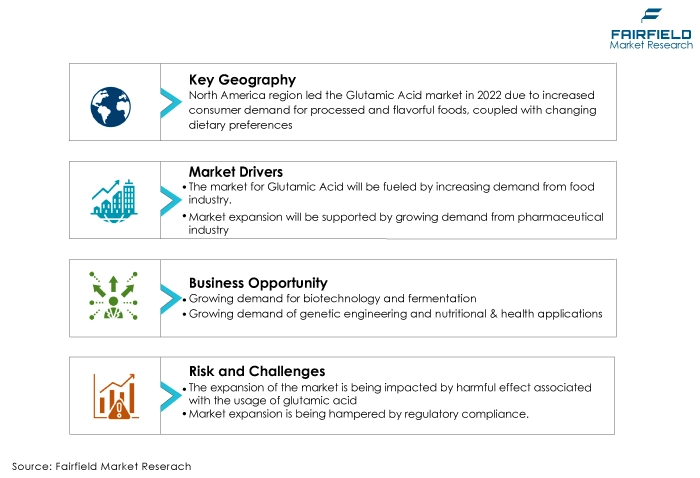
Key Trends and Opportunities to Look at
- Biotechnology and Fermentation
Biotechnology and fermentation technology are pivotal in the glutamic acid market. These processes involve the use of microorganisms to ferment feedstock, such as sugars, into glutamic acid efficiently.
Biotechnology enables genetic optimisation of microbial strains, enhancing yields and reducing production costs. This sustainable approach aligns with the industry's growing demand for eco-friendly, high-quality glutamic acid products used as flavour enhancers and in various applications, including food, pharmaceuticals, and cosmetics.
- Genetic Engineering
Genetic engineering is revolutionising the glutamic acid market by allowing the modification of microbial strains to optimise glutamic acid production. Scientists can manipulate the genetic makeup of microorganisms, enhancing their ability to convert feedstock into glutamic acid efficiently.
The technology increases yields, reduces production costs, and aligns with the market's growing demand for sustainable, high-quality glutamic acid, which is used extensively in food flavour enhancement and various industrial applications.
- Nutritional and Health Applications
Nutritional and health applications in the glutamic acid market involve exploring the potential health benefits of glutamic acid. It plays a crucial role in protein metabolism and is used in dietary supplements. Research is ongoing to understand better its role in promoting muscle growth, cognitive function, and overall well-being. This trend reflects the market's response to consumer demand for functional ingredients and supplements with potential health-enhancing properties.
How Does the Regulatory Scenario Shape this Industry?
The regulatory scenario significantly shapes the glutamic acid market. Food safety and labelling regulations play a pivotal role, with strict limits on the usage of additives like MSG (Monosodium Glutamate), derived from glutamic acid, in various countries.
Compliance with these regulations is paramount for manufacturers to ensure consumer safety and transparency. Labelling requirements for glutamic acid-containing products are subject to scrutiny, with some regions requiring clear identification of MSG.
Additionally, regulatory standards vary globally, necessitating manufacturers to navigate diverse compliance standards, which can impact production processes, labelling, and market access, making regulatory adherence a crucial factor in the glutamic acid industry.
Fairfield’s Ranking Board
Top Segments
- Biosynthesis Product Maintains Dominance
Biosynthesis-derived glutamic acid, primarily produced through fermentation processes using microorganisms, has captured the largest market share in the glutamic acid market due to its eco-friendly and cost-effective nature. This production method is sustainable, aligning with the industry's growing emphasis on environmentally friendly practices.
In addition, biosynthesis allows for precise control over product quality and purity, meeting stringent regulatory requirements. As consumers increasingly prefer natural and clean-label products, biosynthesis-derived glutamic acid gains prominence for its reliability, safety, and sustainability, making it the dominant choice in the market.
Industrial synthesis of glutamic acid is experiencing the fastest CAGR in the market due to its ability to meet growing demand efficiently. This method allows for large-scale production, cost-effectiveness, and consistency in quality. It caters to industries like food and pharmaceuticals where bulk quantities are required.
Moreover, advancements in industrial synthesis technology have improved yield and reduced production costs, making it a preferred choice. As consumption of glutamic acid rises in processed foods and pharmaceuticals, industrial synthesis is crucial in meeting these demands, driving its rapid growth.
- Food Additives to Top Application Area
The food additives application has secured the largest market share in the glutamic acid market due to the widespread use of glutamic acid as a flavour enhancer. It provides a savoury "umami" taste, enhancing the overall flavour profile of processed and convenience foods, including snacks, soups, and ready-to-eat meals.
As consumers seek flavourful and convenient food options, the demand for glutamic acid in the food industry continues to grow, solidifying its dominance in this application and driving its overall market share.
The pharmaceutical application is experiencing the highest CAGR in the glutamic acid market due to its expanding use in drug formulations. Glutamic acid serves as a crucial component in various pharmaceuticals, including antibiotics and vaccines.
As the pharmaceutical industry continues to grow globally and innovate in drug development, the demand for glutamic acid as a key ingredient in these formulations rises significantly. Its role in pharmaceuticals makes it a vital resource within the industry, driving its rapid growth and CAGR.
Regional Frontrunners
North America Remains the Largest Regional Market
North America has captured the largest market share in the glutamic acid market due to several factors. Firstly, the region's well-established food and pharmaceutical industries extensively utilise glutamic acid as a flavour enhancer and in drug formulations.
Stringent regulatory standards and labelling requirements have shaped the market, ensuring product quality and safety. Consumer demand for processed foods and pharmaceutical products with enhanced taste and efficacy has fuelled the adoption of glutamic acid.
Additionally, North American consumers are increasingly seeking clean-label and natural products aligning with glutamic acid's applications. These factors collectively position North America as a dominant player in the glutamic acid market.
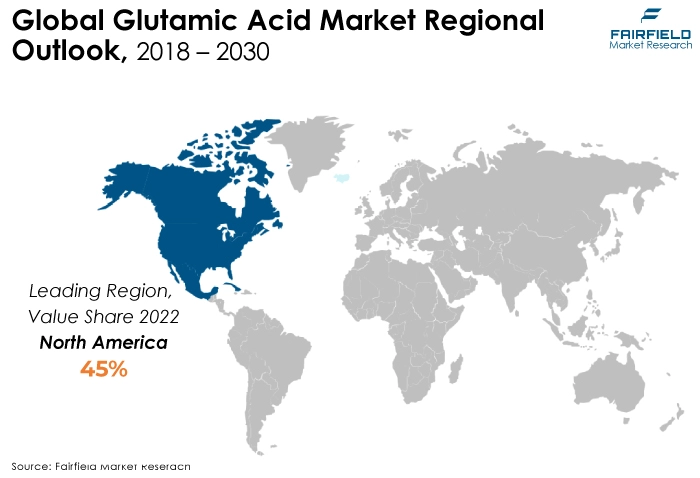
Asia Pacific Likely to Develop a Highly Lucrative Market
The Asia Pacific region is experiencing the highest CAGR in the glutamic acid market due to multiple factors. Rapid industrialisation, population growth, and changing dietary preferences are driving the demand for processed foods and flavour-enhancing ingredients, including glutamic acid. The pharmaceutical industry in Asia Pacific is also expanding, increasing the need for glutamic acid in drug formulations.
Furthermore, the region's cost-effective production capabilities and growing awareness of umami flavours contribute to its remarkable CAGR, making Asia Pacific a key growth engine in the global glutamic acid market.
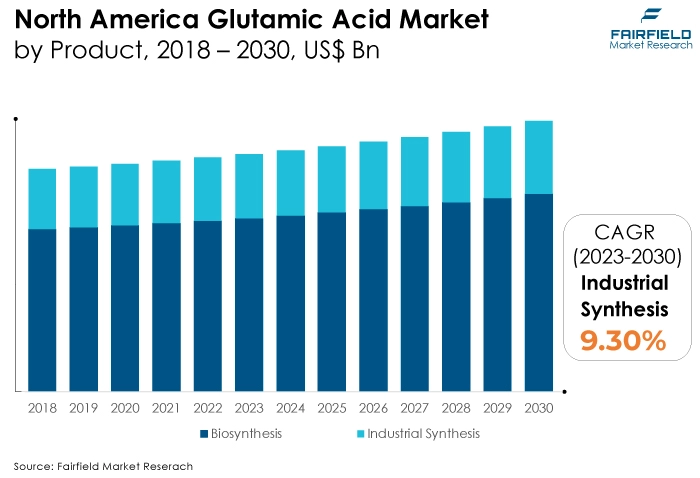
Fairfield’s Competitive Landscape Analysis
The global glutamic acid market is consolidated, with fewer major players present globally. The key players are introducing new products and working on the distribution channels to enhance their worldwide presence. Moreover, Fairfield Market Research expects more consolidation over the coming years.
Who are the Leaders in the Global Glutamic Acid space?
- Ajinomoto Co., Inc.
- CJ CheilJedang Corporation
- Kyowa Hakko Kirin Co., Ltd.
- Evonik Industries AG
- Fufeng Group Limited
- Vedan International (Holdings) Limited
- Meihua Group
- Shandong Qilu Biotechnology Group Co., Ltd.
- Bachem Holding AG
- Daesang Corporation
- Royal DSM N.V.
- Shijiazhuang Donghua Jinlong Chemical Co., Ltd.
- Shanghai Xinjia Industrial Co., Ltd.
- Wuhan Grand Hoyo Co., Ltd.
- Wuhan Wuyao Pharmaceutical Co., Ltd.
Significant Company Developments
New Product Launches
- October 2021: Arla Foods Ingredients has introduced a pure beta-lactoglobulin (BLG) ingredient known as Lacprodan BLG-100. This ingredient boasts 45% higher leucine content, which is the primary amino acid essential for muscle development, compared to the whey protein isolates currently available for commercial use.
- July 2021: Ajinomoto has unveiled an amino acid supplement accompanied by a clinical study and a randomised controlled trial (RCT) aimed at reducing the risk of cognitive decline among healthy middle-aged and elderly individuals who are encountering memory-related issues.
Distribution Agreement
- June 2021: Prinova, a supplier of ingredients, flavours, and nutrient premixes, has introduced a new website designed to improve the procurement of components in the US, and Canada. As part of a broader global website launch, the regional experience in the United States, and Canada offers features such as real-time pricing, access to regulatory documents, and comprehensive information on more than 400 ingredients.
An Expert’s Eye
Demand and Future Growth
As per Fairfield’s Analysis, growth in the food industry is driving the market. The glutamic acid market is characterised by sustained demand driven by its critical role as a flavour enhancer in the food industry.
As consumer preferences for processed and convenient foods persist, the market is expected to grow. Moreover, ongoing research into potential health benefits and applications in pharmaceuticals and cosmetics may further diversify its use.
Expanding global populations and changing consumer preferences are likely to fuel its continued growth, making it a vital component of various industries, including food, pharmaceuticals, and more.
Supply Side of the Market
The major countries in the glutamic acid market include Japan, China, the United States, South Korea, and Indonesia. Japan, being one of the largest consumers of glutamic acid, leads the market. China's robust manufacturing capabilities and growing food industry contribute significantly to its market share.
The United States, and South Korea also have a substantial presence, driven by the processed food and pharmaceutical sectors. Additionally, Indonesia is emerging as a key player, reflecting the global growth of the glutamic acid market. The major raw materials required for glutamic acid production include sugars (such as glucose, or sucrose) and ammonia. These serve as feedstock for fermentation processes.
Additionally, various nutrients and minerals are needed to support microbial growth during fermentation. Major raw material suppliers for the glutamic acid market include companies like Cargill, Archer Daniels Midland Company (ADM), Roquette, and Ajinomoto, which provide essential ingredients and nutrients required for fermentation processes. These suppliers play a crucial role in supporting the production of glutamic acid by manufacturers in the industry.
The Global Glutamic Acid Market is Segmented as Below:
By Product:
- Biosynthesis
- Industrial Synthesis
By Application:
- Food Additives
- Cosmetics
- Pharmaceutical
- Animal & Pet Food
By Geographic Coverage:
- North America
- The U.S.
- Canada
- Europe
- Germany
- U.K.
- France
- Italy
- Turkey
- Russia
- Rest of Europe
- Asia Pacific
- China
- Japan
- South Korea
- India
- Southeast Asia
- Rest of Asia Pacific
- Latin America
- Brazil
- Mexico
- Argentina
- Rest of Latin America
- Middle East & Africa
- GCC
- South Africa
- Egypt
- Nigeria
- Rest of the Middle East & Africa
1. Executive Summary
1.1. Global Glutamic Acid Market Snapshot
1.2. Future Projections
1.3. Key Market Trends
1.4. Regional Snapshot, by Value, 2022
1.5. Analyst Recommendations
2. Market Overview
2.1. Market Definitions and Segmentations
2.2. Market Dynamics
2.2.1. Drivers
2.2.2. Restraints
2.2.3. Market Opportunities
2.3. Value Chain Analysis
2.4. Porter’s Five Forces Analysis
2.5. Covid-19 Impact Analysis
2.5.1. Supply
2.5.2. Demand
2.6. Impact of Ukraine-Russia Conflict
2.7. Economic Overview
2.7.1. World Economic Projections
2.8. PESTLE Analysis
3. Global Glutamic Acid Market Outlook, 2018 - 2030
3.1. Global Glutamic Acid Market Outlook, by Product, Value (US$ Bn), 2018 - 2030
3.1.1. Key Highlights
3.1.1.1. Biosynthesis
3.1.1.2. Industrial Synthesis
3.2. Global Glutamic Acid Market Outlook, by Application, Value (US$ Bn), 2018 - 2030
3.2.1. Key Highlights
3.2.1.1. Food Additives
3.2.1.2. Cosmetics
3.2.1.3. Pharmaceutical
3.2.1.4. Animal & Pet Food
3.3. Global Glutamic Acid Market Outlook, by Region, Value (US$ Bn), 2018 - 2030
3.3.1. Key Highlights
3.3.1.1. North America
3.3.1.2. Europe
3.3.1.3. Asia Pacific
3.3.1.4. Latin America
3.3.1.5. Middle East & Africa
4. North America Glutamic Acid Market Outlook, 2018 - 2030
4.1. North America Glutamic Acid Market Outlook, by Product, Value (US$ Bn), 2018 - 2030
4.1.1. Key Highlights
4.1.1.1. Biosynthesis
4.1.1.2. Industrial Synthesis
4.2. North America Glutamic Acid Market Outlook, by Application, Value (US$ Bn), 2018 - 2030
4.2.1. Key Highlights
4.2.1.1. Food Additives
4.2.1.2. Cosmetics
4.2.1.3. Pharmaceutical
4.2.1.4. Animal & Pet Food
4.2.2. BPS Analysis/Market Attractiveness Analysis
4.3. North America Glutamic Acid Market Outlook, by Country, Value (US$ Bn), 2018 - 2030
4.3.1. Key Highlights
4.3.1.1. U.S. Glutamic Acid Market Product, Value (US$ Bn), 2018 - 2030
4.3.1.2. U.S. Glutamic Acid Market Application, Value (US$ Bn), 2018 - 2030
4.3.1.3. Canada Glutamic Acid Market Product, Value (US$ Bn), 2018 - 2030
4.3.1.4. Canada Glutamic Acid Market Application, Value (US$ Bn), 2018 - 2030
4.3.2. BPS Analysis/Market Attractiveness Analysis
5. Europe Glutamic Acid Market Outlook, 2018 - 2030
5.1. Europe Glutamic Acid Market Outlook, by Product, Value (US$ Bn), 2018 - 2030
5.1.1. Key Highlights
5.1.1.1. Biosynthesis
5.1.1.2. Industrial Synthesis
5.2. Europe Glutamic Acid Market Outlook, by Application, Value (US$ Bn), 2018 - 2030
5.2.1. Key Highlights
5.2.1.1. Food Additives
5.2.1.2. Cosmetics
5.2.1.3. Pharmaceutical
5.2.1.4. Animal & Pet Food
5.2.2. BPS Analysis/Market Attractiveness Analysis
5.3. Europe Glutamic Acid Market Outlook, by Country, Value (US$ Bn), 2018 - 2030
5.3.1. Key Highlights
5.3.1.1. Germany Glutamic Acid Market Product, Value (US$ Bn), 2018 - 2030
5.3.1.2. Germany Glutamic Acid Market Application, Value (US$ Bn), 2018 - 2030
5.3.1.3. U.K. Glutamic Acid Market Product, Value (US$ Bn), 2018 - 2030
5.3.1.4. U.K. Glutamic Acid Market Application, Value (US$ Bn), 2018 - 2030
5.3.1.5. France Glutamic Acid Market Product, Value (US$ Bn), 2018 - 2030
5.3.1.6. France Glutamic Acid Market Application, Value (US$ Bn), 2018 - 2030
5.3.1.7. Italy Glutamic Acid Market Product, Value (US$ Bn), 2018 - 2030
5.3.1.8. Italy Glutamic Acid Market Application, Value (US$ Bn), 2018 - 2030
5.3.1.9. Turkey Glutamic Acid Market Product, Value (US$ Bn), 2018 - 2030
5.3.1.10. Turkey Glutamic Acid Market Application, Value (US$ Bn), 2018 - 2030
5.3.1.11. Russia Glutamic Acid Market Product, Value (US$ Bn), 2018 - 2030
5.3.1.12. Russia Glutamic Acid Market Application, Value (US$ Bn), 2018 - 2030
5.3.1.13. Rest of Europe Glutamic Acid Market Product, Value (US$ Bn), 2018 - 2030
5.3.1.14. Rest of Europe Glutamic Acid Market Application, Value (US$ Bn), 2018 - 2030
5.3.2. BPS Analysis/Market Attractiveness Analysis
6. Asia Pacific Glutamic Acid Market Outlook, 2018 - 2030
6.1. Asia Pacific Glutamic Acid Market Outlook, by Product, Value (US$ Bn), 2018 - 2030
6.1.1. Key Highlights
6.1.1.1. Biosynthesis
6.1.1.2. Industrial Synthesis
6.2. Asia Pacific Glutamic Acid Market Outlook, by Application, Value (US$ Bn), 2018 - 2030
6.2.1. Key Highlights
6.2.1.1. Food Additives
6.2.1.2. Cosmetics
6.2.1.3. Pharmaceutical
6.2.1.4. Animal & Pet Food
6.2.2. BPS Analysis/Market Attractiveness Analysis
6.3. Asia Pacific Glutamic Acid Market Outlook, by Country, Value (US$ Bn), 2018 - 2030
6.3.1. Key Highlights
6.3.1.1. China Glutamic Acid Market Product, Value (US$ Bn), 2018 - 2030
6.3.1.2. China Glutamic Acid Market by Application, Value (US$ Bn), 2018 - 2030
6.3.1.3. Japan Glutamic Acid Market Product, Value (US$ Bn), 2018 - 2030
6.3.1.4. Japan Glutamic Acid Market Application, Value (US$ Bn), 2018 - 2030
6.3.1.5. South Korea Glutamic Acid Market Product, Value (US$ Bn), 2018 - 2030
6.3.1.6. South Korea Glutamic Acid Market Application, Value (US$ Bn), 2018 - 2030
6.3.1.7. India Glutamic Acid Market Product, Value (US$ Bn), 2018 - 2030
6.3.1.8. India Glutamic Acid Market Application, Value (US$ Bn), 2018 - 2030
6.3.1.9. Southeast Asia Glutamic Acid Market Product, Value (US$ Bn), 2018 - 2030
6.3.1.10. Southeast Asia Glutamic Acid Market Application, Value (US$ Bn), 2018 - 2030
6.3.1.11. Rest of Asia Pacific Glutamic Acid Market Product, Value (US$ Bn), 2018 - 2030
6.3.1.12. Rest of Asia Pacific Glutamic Acid Market Application, Value (US$ Bn), 2018 - 2030
6.3.2. BPS Analysis/Market Attractiveness Analysis
7. Latin America Glutamic Acid Market Outlook, 2018 - 2030
7.1. Latin America Glutamic Acid Market Outlook, by Product, Value (US$ Bn), 2018 - 2030
7.1.1. Key Highlights
7.1.1.1. Biosynthesis
7.1.1.2. Industrial Synthesis
7.2. Latin America Glutamic Acid Market Outlook, by Application, Value (US$ Bn), 2018 - 2030
7.2.1. Key Highlights
7.2.1.1. Food Additives
7.2.1.2. Cosmetics
7.2.1.3. Pharmaceutical
7.2.1.4. Animal & Pet Food
7.2.2. BPS Analysis/Market Attractiveness Analysis
7.3. Latin America Glutamic Acid Market Outlook, by Country, Value (US$ Bn), 2018 - 2030
7.3.1. Key Highlights
7.3.1.1. Brazil Glutamic Acid Market Product, Value (US$ Bn), 2018 - 2030
7.3.1.2. Brazil Glutamic Acid Market Application, Value (US$ Bn), 2018 - 2030
7.3.1.3. Mexico Glutamic Acid Market Product, Value (US$ Bn), 2018 - 2030
7.3.1.4. Mexico Glutamic Acid Market Application, Value (US$ Bn), 2018 - 2030
7.3.1.5. Argentina Glutamic Acid Market Product, Value (US$ Bn), 2018 - 2030
7.3.1.6. Argentina Glutamic Acid Market Application, Value (US$ Bn), 2018 - 2030
7.3.1.7. Rest of Latin America Glutamic Acid Market Product, Value (US$ Bn), 2018 - 2030
7.3.1.8. Rest of Latin America Glutamic Acid Market Application, Value (US$ Bn), 2018 - 2030
7.3.2. BPS Analysis/Market Attractiveness Analysis
8. Middle East & Africa Glutamic Acid Market Outlook, 2018 - 2030
8.1. Middle East & Africa Glutamic Acid Market Outlook, by Product, Value (US$ Bn), 2018 - 2030
8.1.1. Key Highlights
8.1.1.1. Biosynthesis
8.1.1.2. Industrial Synthesis
8.2. Middle East & Africa Glutamic Acid Market Outlook, by Application, Value (US$ Bn), 2018 - 2030
8.2.1. Key Highlights
8.2.1.1. Food Additives
8.2.1.2. Cosmetics
8.2.1.3. Pharmaceutical
8.2.1.4. Animal & Pet Food
8.2.2. BPS Analysis/Market Attractiveness Analysis
8.3. Middle East & Africa Glutamic Acid Market Outlook, by Country, Value (US$ Bn), 2018 - 2030
8.3.1. Key Highlights
8.3.1.1. GCC Glutamic Acid Market Product, Value (US$ Bn), 2018 - 2030
8.3.1.2. GCC Glutamic Acid Market Application, Value (US$ Bn), 2018 - 2030
8.3.1.3. South Africa Glutamic Acid Market Product, Value (US$ Bn), 2018 - 2030
8.3.1.4. South Africa Glutamic Acid Market Application, Value (US$ Bn), 2018 - 2030
8.3.1.5. Egypt Glutamic Acid Market Product, Value (US$ Bn), 2018 - 2030
8.3.1.6. Egypt Glutamic Acid Market Application, Value (US$ Bn), 2018 - 2030
8.3.1.7. Nigeria Glutamic Acid Market Product, Value (US$ Bn), 2018 - 2030
8.3.1.8. Nigeria Glutamic Acid Market Application, Value (US$ Bn), 2018 - 2030
8.3.1.9. Rest of Middle East & Africa Glutamic Acid Market Product, Value (US$ Bn), 2018 - 2030
8.3.1.10. Rest of Middle East & Africa Glutamic Acid Market Application, Value (US$ Bn), 2018 - 2030
8.3.2. BPS Analysis/Market Attractiveness Analysis
9. Competitive Landscape
9.1. Manufacturer vs Application Heatmap
9.2. Company Market Share Analysis, 2022
9.3. Competitive Dashboard
9.4. Company Profiles
9.4.1. Ajinomoto Co., Inc.
9.4.1.1. Company Overview
9.4.1.2. Product Portfolio
9.4.1.3. Financial Overview
9.4.1.4. Business Strategies and Development
9.4.2. CJ CheilJedang Corporation
9.4.2.1. Company Overview
9.4.2.2. Product Portfolio
9.4.2.3. Financial Overview
9.4.2.4. Business Strategies and Development
9.4.3. Kyowa Hakko Kirin Co., Ltd.
9.4.3.1. Company Overview
9.4.3.2. Product Portfolio
9.4.3.3. Financial Overview
9.4.3.4. Business Strategies and Development
9.4.4. Evonik Industries AG
9.4.4.1. Company Overview
9.4.4.2. Product Portfolio
9.4.4.3. Financial Overview
9.4.4.4. Business Strategies and Development
9.4.5. Fufeng Group Limited
9.4.5.1. Company Overview
9.4.5.2. Product Portfolio
9.4.5.3. Financial Overview
9.4.5.4. Business Strategies and Development
9.4.6. Vedan International (Holdings) Limited
9.4.6.1. Company Overview
9.4.6.2. Product Portfolio
9.4.6.3. Financial Overview
9.4.6.4. Business Strategies and Development
9.4.7. Meihua Group
9.4.7.1. Company Overview
9.4.7.2. Product Portfolio
9.4.7.3. Financial Overview
9.4.7.4. Business Strategies and Development
9.4.8. Shandong Qilu Biotechnology Group Co., Ltd.
9.4.8.1. Company Overview
9.4.8.2. Product Portfolio
9.4.8.3. Financial Overview
9.4.8.4. Business Strategies and Development
9.4.9. Bachem Holding AG
9.4.9.1. Company Overview
9.4.9.2. Product Portfolio
9.4.9.3. Financial Overview
9.4.9.4. Business Strategies and Development
9.4.10. Daesang Corporation
9.4.10.1. Company Overview
9.4.10.2. Product Portfolio
9.4.10.3. Financial Overview
9.4.10.4. Business Strategies and Development
9.4.11. Royal DSM N.V.
9.4.11.1. Company Overview
9.4.11.2. Product Portfolio
9.4.11.3. Financial Overview
9.4.11.4. Business Strategies and Development
9.4.12. Shijiazhuang Donghua Jinlong Chemical Co., Ltd.
9.4.12.1. Company Overview
9.4.12.2. Product Portfolio
9.4.12.3. Financial Overview
9.4.12.4. Business Strategies and Development
9.4.13. Shanghai Xinjia Industrial Co., Ltd.
9.4.13.1. Company Overview
9.4.13.2. Product Portfolio
9.4.13.3. Financial Overview
9.4.13.4. Business Strategies and Development
9.4.14. Wuhan Wuyao Pharmaceutical Co., Ltd.
9.4.14.1. Company Overview
9.4.14.2. Product Portfolio
9.4.14.3. Financial Overview
9.4.14.4. Business Strategies and Development
9.4.15. Wuhan Grand Hoyo Co., Ltd.
9.4.15.1. Company Overview
9.4.15.2. Product Portfolio
9.4.15.3. Financial Overview
9.4.15.4. Business Strategies and Development
10. Appendix
10.1. Research Methodology
10.2. Report Assumptions
10.3. Acronyms and Abbreviations
|
BASE YEAR |
HISTORICAL DATA |
FORECAST PERIOD |
UNITS |
|||
|
2022 |
|
2018 - 2022 |
2023 - 2030 |
Value: US$ Million |
||
|
REPORT FEATURES |
DETAILS |
|
Product Coverage |
|
|
Application Coverage |
|
|
Geographical Coverage |
|
|
Leading Companies |
|
|
Report Highlights |
Key Market Indicators, Macro-micro economic impact analysis, Technological Roadmap, Key Trends, Driver, Restraints, and Future Opportunities & Revenue Pockets, Porter’s 5 Forces Analysis, Historical Trend (2019-2021), Market Estimates and Forecast, Market Dynamics, Industry Trends, Competition Landscape, Category, Region, Country- wise Trends & Analysis, COVID-19 Impact Analysis (Demand and Supply Chain) |
